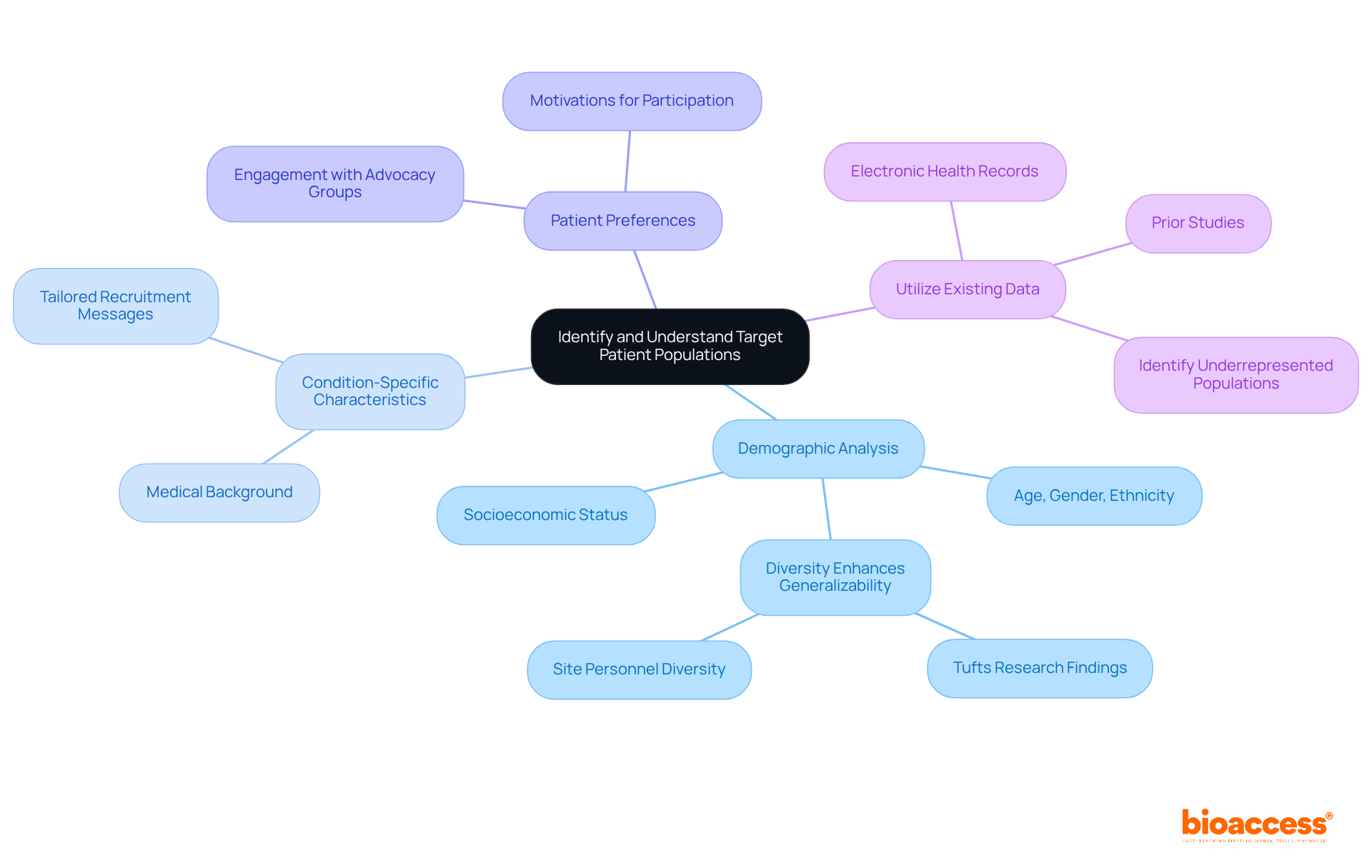


Effective recruitment strategies in clinical trials are crucial for understanding target patient populations, exploring diverse recruitment methods, and enhancing patient engagement to ensure successful enrollment. By analyzing demographics and utilizing digital platforms, researchers can significantly optimize their recruitment efforts. Clear communication plays a vital role in improving participant retention, ultimately leading to more robust clinical study outcomes.
In the ever-evolving Medtech landscape, the role of bioaccess in addressing key challenges cannot be overstated. As clinical trials become increasingly complex, the need for innovative recruitment strategies becomes paramount. Researchers must consider how to effectively engage potential participants, ensuring that their studies reflect the diverse populations they aim to serve.
Collaboration among stakeholders is essential for navigating these challenges. By leveraging data and research findings, clinical researchers can enhance their recruitment strategies, fostering a more inclusive environment for participants. The importance of these efforts cannot be underestimated, as they directly impact the quality and reliability of clinical study results.
In conclusion, the path forward involves a commitment to refining recruitment strategies and enhancing patient engagement. By prioritizing these elements, researchers can not only improve enrollment rates but also contribute to the advancement of clinical research as a whole.
In the intricate realm of clinical trials, effectively recruiting and retaining participants is pivotal to the success of research outcomes. Understanding the nuances of target patient populations and employing diverse recruitment methods are essential strategies that can significantly enhance enrollment rates and uphold the integrity of study results.
However, researchers face the daunting challenge of reaching underrepresented groups and maintaining participant engagement. How can they navigate these obstacles to foster a more inclusive and effective recruitment process?
By exploring innovative approaches and best practices in recruitment, researchers not only address these challenges but also pave the way for more successful clinical trials.
To successfully enlist individuals for clinical studies, recognizing and comprehending the target demographic is crucial. This involves defining the ideal participant profile based on specific inclusion and exclusion criteria relevant to the study. Key steps include:
Demographic Analysis: Analyze demographic factors such as age, gender, ethnicity, and socioeconomic status to ensure a representative sample. Research from the Tufts Center for the Study of Drug Development indicates that a variety of trial subjects enhances the generalizability of study findings. Kenneth Getz highlights that the relationship between site personnel diversity and participant enrollment diversity is essential for effective recruitment.
Condition-Specific Characteristics: Understand the medical background and specific conditions of possible candidates to customize recruitment messages. This targeted approach can significantly improve engagement and interest.
Patient Preferences: Engage with patient advocacy groups to gather insights on what motivates patients to participate in clinical trials. This partnership can guide hiring approaches that connect with prospective individuals, nurturing a sense of community and collective purpose.
Utilize Existing Data: Leverage electronic health records and prior studies to identify suitable individuals who meet the criteria. This approach not only streamlines the recruitment process but also enhances the likelihood of reaching underrepresented populations. Significantly, merely 17% of individuals in industry-funded research are racially or ethnically varied, emphasizing the importance of demographic examination in enhancing diversity in clinical studies.
By thoroughly understanding the target population, researchers can develop more effective recruitment strategies that resonate with prospective individuals, ultimately leading to higher enrollment rates and more robust study results. Furthermore, the increasing trend of virtual clinical studies can aid demographic analysis, simplifying access to varied groups of individuals.

To enhance recruitment success, it’s essential to explore various recruitment strategies in clinical trials and avenues for reaching prospective individuals, especially in a competitive environment like Colombia, which offers significant advantages for clinical studies. Effective strategies include:
Digital Platforms: Leverage social media, user matching platforms, and online forums to connect with potential participants. Platforms such as Facebook and Instagram are particularly effective for targeted advertising, especially considering Colombia's large population of over 50 million, with 95% covered by universal healthcare. Highlighting the financial benefits of conducting experiments in Colombia can also attract contributors.
Community Engagement: Partner with local healthcare providers, community organizations, and patient advocacy groups to raise awareness about the study and its benefits. Colombia's high-quality healthcare system, ranked among the best in Latin America, can foster trust and encourage participation.
Direct Outreach: Implement direct outreach strategies, including email campaigns and phone calls, to engage potential participants who may not be actively seeking trial opportunities. The regulatory pace in Colombia, with IRB/EC and MoH evaluations taking only 90-120 days, allows for quicker interaction with individuals.
Incentives and Reimbursements: Provide incentives for participation, such as travel reimbursements or compensation for time, to boost enrollment. Additionally, utilizing Colombia's R&D tax incentives can offer financial support for these initiatives.
By diversifying recruitment strategies in clinical trials and capitalizing on Colombia's unique benefits, including cost efficiency, researchers can broaden their reach and enhance the likelihood of enrolling a sufficient number of individuals.

Improving patient involvement and retention is crucial for the success of recruitment strategies in clinical trials. Effective strategies to achieve this include:
Clear Communication: Establishing open lines of communication with attendees is vital. Frequent updates regarding the progress of the proceedings and any protocol modifications foster trust and keep participants informed. Research indicates that individuals who feel informed about their participation are more likely to stay engaged, with consistent communication identified as the second most critical factor for retention.
Patient-Centric Approach: Designing trials with the patient experience in mind minimizes burdens such as unnecessary visits or invasive procedures. A patient-first approach not only enhances satisfaction among individuals but also positively impacts recruitment strategies in clinical trials by leading to improved retention rates. This is evidenced by high retention levels in resource-challenged countries, reaching up to 100%.
Feedback Mechanisms: Establishing systems for individuals to share their experiences encourages a sense of involvement and ownership. This feedback can illuminate areas for enhancement, ensuring that the study remains attentive to the needs of those involved. Data analysis has shown that capturing patient sentiment can proactively address potential dropout issues.
Support Services: Providing assistance, such as counseling or educational resources, significantly aids individuals in managing their engagement in the study. Offering these resources not only enhances the experience of participants but also addresses common dropout factors, such as financial pressures and insufficient knowledge about the trial's benefits.
By prioritizing patient engagement and retention through effective communication and support, researchers can improve their recruitment strategies in clinical trials to create a more positive experience for participants. This approach leads to higher retention rates and more comprehensive data collection.

Understanding and implementing effective recruitment strategies in clinical trials is essential for achieving successful outcomes. By focusing on the right patient populations, employing diverse recruitment methods, and enhancing patient engagement, researchers can significantly improve enrollment rates and the overall quality of clinical studies.
Key insights emphasize the importance of:
Utilizing digital platforms, community engagement, and direct outreach can broaden recruitment efforts. Moreover, enhancing patient engagement through clear communication, a patient-centric approach, and support services solidifies retention, ensuring that studies are not only well-populated but also yield reliable data.
As the landscape of clinical trials evolves, embracing these best practices becomes crucial. Researchers are encouraged to adopt innovative recruitment techniques and prioritize patient experiences, ultimately fostering a more inclusive and effective research environment. By doing so, the clinical research community can work towards more successful trials, benefiting both participants and the advancement of medical science.
Why is it important to identify and understand target patient populations for clinical studies?
Recognizing and comprehending the target demographic is crucial for successfully enlisting individuals for clinical studies, as it helps define the ideal participant profile based on specific inclusion and exclusion criteria relevant to the study.
What demographic factors should be analyzed when identifying target populations?
Key demographic factors include age, gender, ethnicity, and socioeconomic status, which ensure a representative sample and enhance the generalizability of study findings.
How does the diversity of trial subjects impact clinical study findings?
A variety of trial subjects enhances the generalizability of study findings, making the results more applicable to a broader population.
What role do condition-specific characteristics play in recruitment?
Understanding the medical background and specific conditions of potential candidates allows researchers to customize recruitment messages, significantly improving engagement and interest.
How can patient preferences influence recruitment strategies?
Engaging with patient advocacy groups provides insights into what motivates patients to participate in clinical trials, guiding recruitment approaches that foster a sense of community and purpose.
What existing data can be utilized to identify suitable individuals for clinical studies?
Researchers can leverage electronic health records and prior studies to identify individuals who meet the study criteria, streamlining the recruitment process and enhancing the likelihood of reaching underrepresented populations.
What is the current state of racial and ethnic diversity in clinical research?
Only 17% of individuals in industry-funded research are racially or ethnically varied, highlighting the importance of demographic examination to enhance diversity in clinical studies.
How can virtual clinical studies assist in demographic analysis?
The increasing trend of virtual clinical studies can simplify access to varied groups of individuals, aiding in demographic analysis and improving recruitment strategies.